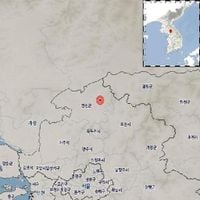On May 10, 2025, a magnitude 3.3 earthquake struck Yeoncheon-gun, Gyeonggi Province, at approximately 1:19 PM. The earthquake occurred 5 kilometers northeast of the town, with an epicenter located at 38.14 degrees north latitude and 127.09 degrees east longitude, and at a depth of 9 kilometers. This seismic event was significant enough to be felt across various regions, particularly in Gyeonggi and northern Gangwon provinces.
The Korea Meteorological Administration (KMA) reported that the maximum perceived seismic intensity reached 4 in Gyeonggi Province, 3 in Gangwon Province, and 2 in Incheon. Such intensity levels indicate that many people indoors would have felt the tremors, with household items like dishes and windows shaking noticeably. The KMA explained that intensity level 4 means 'many people indoors feel the shaking, and items like dishes and windows rattle,' while level 3 indicates that 'people on upper floors of buildings feel it significantly, and stationary vehicles may shake slightly.' In contrast, level 2 is only felt by a few individuals in quiet areas or on upper floors.
Shortly after the earthquake, the fire department received a total of 12 reports of tremors. Specifically, there were 3 reports each from Seoul and Incheon, along with 6 reports from Gyeonggi Province. Fortunately, there were no reports of injuries or property damage related to the earthquake. Despite the absence of damage, the KMA urged residents in the affected areas to remain vigilant and prioritize safety in case of aftershocks.
This earthquake is noteworthy as it is the fifth strongest among the 28 earthquakes of magnitude 2.0 or higher that have occurred in and around the Korean Peninsula this year. Remarkably, just five days prior, on May 5, 2025, a stronger earthquake of magnitude 3.7 was recorded 52 kilometers northwest of Taean-gun, Chungnam, marking it as the most powerful quake of the year so far.
Interestingly, the location of this earthquake is not known for frequent seismic activity. Since 1978, there have been only 17 earthquakes of magnitude 2.0 or higher within a 50-kilometer radius of the epicenter, and this recent quake is the largest among them.
The KMA's assessment indicated that the tremors from this earthquake were felt widely, suggesting that residents in the metropolitan area of Seoul experienced the shaking. Social media platforms were abuzz with users reporting their experiences, with many sharing their feelings of unease and surprise.
In response to the quake, local authorities have been monitoring the situation closely. The KMA continues to analyze seismic data to assess potential aftershocks and ensure public safety. They have reiterated the importance of preparedness, especially in a region that may not be accustomed to such seismic events.
The occurrence of this earthquake has sparked discussions among experts about the geological stability of the region. While South Korea has not historically been known for severe earthquakes, the recent increase in seismic activity has raised questions about the need for improved infrastructure and emergency preparedness.
As communities reflect on this event, many are reminded of the importance of earthquake preparedness and awareness. Local governments are expected to review their emergency response plans and educate residents on safety measures to take during seismic events.
In summary, the magnitude 3.3 earthquake that rattled Yeoncheon-gun serves as a reminder of the unpredictable nature of seismic activity. While the immediate impact was minimal, the event has prompted a broader conversation about safety and preparedness in the face of natural disasters.
![[속보] 기상청 “경기 연천 북북동쪽서 규모 3.3 지진 발생”](https://thumbor.evrimagaci.org/vGyUCKarpiIrM4d-_jicfb739T8=/200x0/tpg%2Fsources%2F87d229af-45dd-4359-a639-9a3df2ef2ee7.jpeg)




